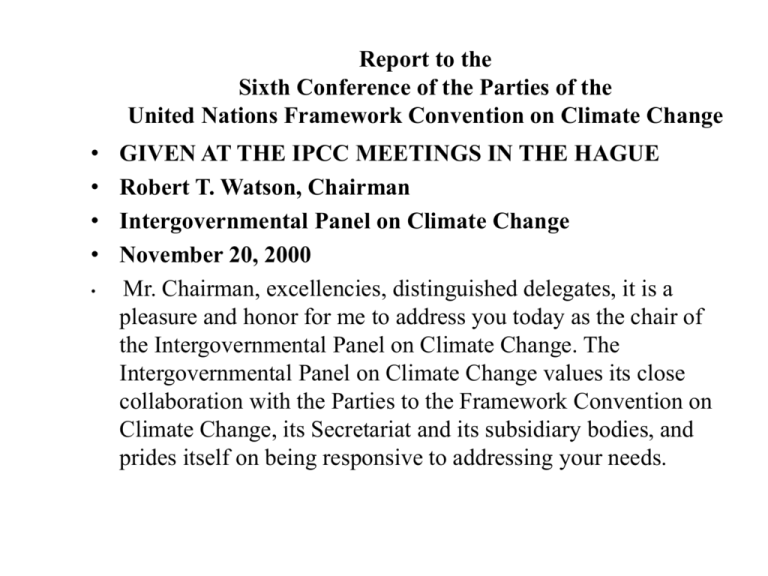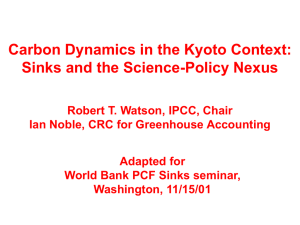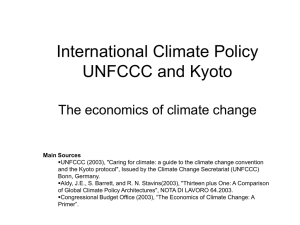2000-2006 - Institute for Research and Innovation in Sustainability
advertisement

Report to the Sixth Conference of the Parties of the United Nations Framework Convention on Climate Change • • • • • GIVEN AT THE IPCC MEETINGS IN THE HAGUE Robert T. Watson, Chairman Intergovernmental Panel on Climate Change November 20, 2000 Mr. Chairman, excellencies, distinguished delegates, it is a pleasure and honor for me to address you today as the chair of the Intergovernmental Panel on Climate Change. The Intergovernmental Panel on Climate Change values its close collaboration with the Parties to the Framework Convention on Climate Change, its Secretariat and its subsidiary bodies, and prides itself on being responsive to addressing your needs. More of the speech • As you debate the weighty issues associated with effective implementation of the Convention and the Kyoto Protocol let me remind you that the overwhelming majority of scientific experts, whilst recognizing that scientific uncertainties exist, nonetheless believe that human-induced climate change is already occurring and that future change is inevitable. It is not a question of whether the Earth’s climate will change, but rather by how much, how fast and where. It is undisputed that the two last decades has been the warmest this century, indeed the warmest for the last 1000 years, sea level is rising, precipitation patterns are changing, Arctic sea ice is thinning and the frequency and intensity of El-Nino events appear to be increasing. In addition, many parts of the world have recently suffered major heat-waves, floods, droughts and extreme weather events leading to significant loss of life and economic costs. More of the speech • While individual extreme weather events cannot be directly linked to human-induced climate change, the frequency and magnitude of these types of events are expected to increase in a warmer world. Climate models, using the latest emissions projections from the IPCC Special Report on Emissions Scenarios, project an increase in global mean surface temperature of 1.5 to 6 degrees Centigrade between 1990 and 2100, with land areas warming more than the global average, especially at mid-and high northern latitudes. These changes in temperature will be accompanied by changes in precipitation patterns and sea level rise. More of the speech • As the Earth warms, models project that: • arid and semi-arid land areas in Southern Africa, the Middle East, Southern Europe and Australia become even more water stressed than they are today; • agricultural production in many tropical and sub-tropical countries decreases, especially in Africa and Latin America; • the incidence of vector-borne diseases, such as malaria and dengue, increases in tropical countries; More of the speech • As the Earth warms, models project that: • tens of millions of people will be displaced by rising sea levels in Small Island States and low-lying deltaic areas; and • the structure and functioning of critical ecological systems, particularly coral reefs and forests, will change affecting their goods and services which are vital for sustainable development. More of the speech • These adverse impacts will severely undermine the goal of sustainable development in many parts of the world, with developing countries, and the poor in developing countries, being most vulnerable. However, it should be noted that some of these projected adverse effects can, to some degree, be reduced through proactive adaptation measures. More of the speech • The good news is, however, that the majority of experts believe that significant reductions in net greenhouse gas emissions are technically feasible, both in the short- and longer-term, due to an extensive array of technologies and policy measures in Annex I countries in the energy supply, energy demand and in the agricultural and forestry sectors. In addition, subject to further elaboration, the flexible instruments of Articles 6, 12 and 17, can be used to reduce cost of greenhouse gas emissions reductions for Annex I countries and Articles 6 and 12 can facilitate the transfer of environmentally sound technologies. Thus the short-term goal of the Kyoto Protocol, and the longer-term goal of the UN Framework on Climate Change (Article 2), stabilization of the atmospheric concentrations of greenhouse gases, are technically and economically feasible without the premature retirement of capital stock. Now is the time for the ratification and implementation of the Kyoto Protocol if those commitment targets are to be realized. More of the speech • Given the challenges of improving indoor and outdoor air quality in many parts of the world, and the goals to reduce acid deposition, land degradation and protect biodiversity, policies, practices and technologies that can simultaneously address these local and regional environmental issues, while reducing net greenhouse gas emissions are particularly attractive. Estimates of the costs of mitigating climate change should take into account the co-benefits of switching from a fossil fuel based economy to a lower-carbon intensity energy system. Co-benefits from energy sector interventions could include lower levels of local and regional pollution, while co-benefits from agricultural and forestry sector interventions could include increased soil fertility and reduced loss of biodiversity. Hence, such interventions would have both social and economic benefits at the local as well as global scale. More of the speech • Mr. Chairman, in the remainder of my presentation today I would like to briefly review some of the recent findings of approved IPCC reports which have a direct bearing on some of the issues you are debating: More of the speech • First, the Special Report on Methodological and Technological Issues in Technology Transfer concluded that the current efforts and established processes for facilitating the flows of knowledge, experience and equipment among governments, private sector entities, financial institutions, NGOs, and research and education institutions will not be sufficient to meet the challenge of addressing climate change in the context of sustainable development. Enhanced capacity is required in developing countries and additional government actions are needed to create the enabling environment for private sector technology transfers within and across national boundaries. More of the speech • Government actions could include, inter-alia, reforming legal systems, protecting intellectual property rights and licenses, encouraging financial reforms, promoting competitive and open markets for environmentally sound technologies, and knowledge sharing. Mechanisms for technology transfer include National Systems of Innovation, Official Development Assistance, the Global Environmental Facility, Multilateral Banks and the Kyoto Protocol Mechanisms (Articles 6 and 12) and the UNFCCC. More of the speech • Second, the Special Report on emissions scenarios concluded that different development paths can result in a wide range of future greenhouse gas sulfate aerosol precursor emissions depending on, inter-alia, the evolution of governance structures world-wide, changes in population and economic growth, and broad technological changes, which are particularly sensitive to the level of investment in research and development. Most projections suggest that greenhouse gas concentrations will increase significantly during the next century in the absence of policies specifically designed to address the issue of climate change, with carbon dioxide emissions from the combustion of fossil fuels being projected to range from about 5 to 35 GtC per year in the year 2100, compared to current emissions of about 6.3 GtC per year. More of the speech • Third, the Special Report on land-use, land-use change and forestry concluded that • all relevant forms of "terrestrial" carbon can be adequately monitored to implement the Kyoto Protocol; • there are many options in both Annex I and non-Annex I countries where cost-effective interventions in the agricultural and forestry sectors could reduce net greenhouse gas emissions and have a wide range of co-benefits consistent with sustainable development; • the terrestrial biosphere is currently a net sink for carbon, with an uptake in Annex I countries of about 1.0 - 1.5 GtC per year; and More of the speech • to ensure that changes in terrestrial carbon accurately reflected changes in the atmosphere special attention should be paid to the carbon accounting rules for treating aggradation and degradation in forests and the harvesting-regeneration cycle. • In conclusion, I would like to thank you for allowing me to address you today and remind you that if actions are not taken to reduce the projected increase in greenhouse gas emissions, the Earth’s climate is likely to change at a rate unprecedented in the last 10,000 years with adverse consequences for society, undermining the very foundation of sustainable development. Hence, the welfare of this and future generations is in your hands. As of summer 2002… • Robert Watson was removed as chair of IPCC under pressure from the US government who felt that he was too effective in raising awareness of climate change











